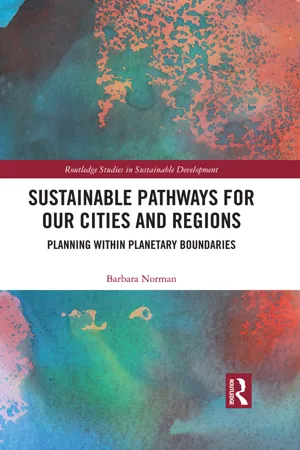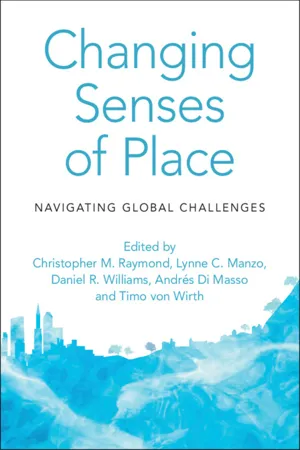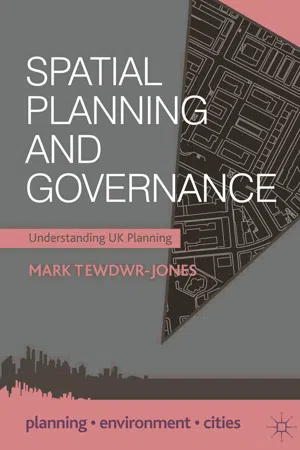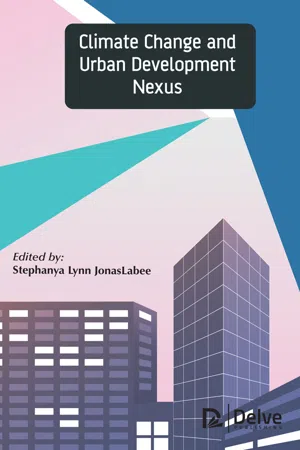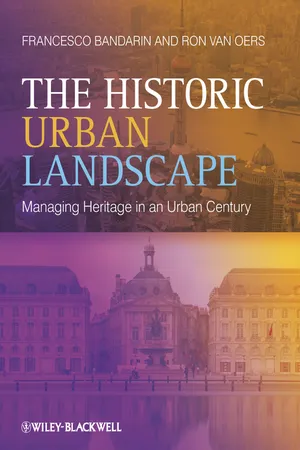Geography
Challenges of Urban Changes
Urban changes present various challenges, including increased demand for infrastructure and services, environmental degradation, and social inequality. Rapid urbanization can strain resources and lead to issues such as traffic congestion and inadequate housing. Additionally, urban changes can impact cultural identity and community cohesion, requiring careful planning and management to address these challenges effectively.
Written by Perlego with AI-assistance
Related key terms
1 of 5
9 Key excerpts on "Challenges of Urban Changes"
- eBook - ePub
Sustainable Pathways for our Cities and Regions
Planning within Planetary Boundaries
- Barbara Norman(Author)
- 2018(Publication Date)
- Routledge(Publisher)
Six . However, the greatest challenges facing cities are the risks associated with climate change. The two great global challenges facing the world in the twenty-first century are the rapid rate of urbanisation and human-induced climate change. The consequences span the sustainability agenda with very significant environmental, social and economic consequences. Dr Cynthia Rosenzweig, director of the global UCCRN, puts it clearly: ‘the rapid rate of climate change combined with massive urbanisation present a double whammy to cities struggling to respond to both challenges’ (Rosenzweig 2016).The spatial dimension of risk can be highlighted through a layering of climate risks on the ground (e.g., coasts and deltas) and on the urban areas experiencing rapid urbanisation. It is then quickly evident where the ‘hotspots’ of climate risk lie. This is particularly where urban growth is extending into and past an urban growth boundary into lands previously seen as vulnerable to environmental change or extreme events (wildfire on the urban edge or flood-prone lands). These marginal lands are often cheaper due to the risks such as floods in river deltas or being subject to landslip or coastal inundation. As a consequence some of the poorest urban communities live in these increasingly hazardous areas. Again equity considerations in urbanisation and planning for climate change warrant much more attention by urban decision makers.When it comes to the impacts of climate change, the Asia Pacific region is where the greatest risk lies. The region is home to many different nations and cultures covering a vast geography – the mountains of the Himalayas, the arid area of East Asia, the deltas of the Mekong, the Yangztse and the Ganges and the tropical and subtropical south Asia. The exposure to the impacts of climate change is high, and being home to the poorest people of the world, the extent of vulnerability is potentially extreme; time is running out for action. In a 2017 assessment of climate risk in the Asia Pacific, the Asian Development Bank (AB) concludes: ‘under a Business-As-Usual (BAU) scenario, which will cause a global mean temperature rise of over 4C by the end of this century, the possibilities for adaptation are drastically reduced’ (ADB 2017, Executive Summary). The extent of persistent poverty exacerbated by social, economic and environmental change makes the task of planning for more sustainable cities and regions seem almost impossible. However, there are strategies that can be implemented. As the ADB suggests: - eBook - ePub
Planning Sustainable Cities
Global Report on Human Settlements 2009
- Un-Habitat(Author)
- 2016(Publication Date)
- Routledge(Publisher)
Future urban planning needs to take place within an understanding of the factors that are shaping the socio-spatial aspects of cities and the institutional structures which attempt to manage them. It also needs to recognize the significant demographic and environmental challenges that lie ahead and for which systems of urban management will have to plan. The overarching global changes that have occurred since the 1970s are first considered, and then the ways in which these impact upon demographic, socio-spatial and institutional change in urban areas and their implications for planning. There are also new forces and views that will impact upon a revised role for urban planning, such as environmental threats and climate change, oil depletion and costs, food security, and post-disaster and post-conflict demands. In all cases, local context shapes the impact of these forces.Main forces affecting urban change
Over the last several decades, global changes in the environment, in the economy, in institutional structures and processes and in civil society have had significant impacts upon urban areas. These trends in the developed, developing and transitional regions of the world are reviewed below.■ Environmental challenges
The Brundtland Commission’s report – Our Common Future – which called for ‘development that meets the needs of the present without compromising the ability of future generations to meet their own needs’, placed the issue of sustainable development at the core of urban policy and planning concerns (see Chapter 6 ). The most important environmental concern now is climate change. The authoritative Stern Report27 on the economics of climate change concludes that it will ‘affect the basic elements of life for people around the world – access to water, food production, health and the environment. Hundreds of millions of people could suffer hunger, water shortages and coastal flooding as the world warms.’ Moreover, it will be the poorest countries and people who are most vulnerable to this threat who will suffer the most. Current forms of urbanization are pushing the lowest-income people into locations that are prone to natural hazards, such that four out of every ten non-permanent houses in the developing world are now located in areas threatened by floods, landslides and other natural disasters.28A second major environmental concern is oil supply and the likely long-term increase in the cost of fossil fuels. The global use of oil as an energy source has both promoted and permitted urbanization, and its easy availability has allowed the emergence of low-density and sprawling urban forms – suburbia – dependent upon private cars. Beyond this, however, the entire global economy rests on the possibility of moving both people and goods quickly, cheaply and over long distances. An oil-based economy and climate change are linked: vehicle and aircraft emissions contribute significantly to greenhouse gas emissions and, hence, global warming. One reason for the current global food crisis is unpredictable spikes in the cost of oil. Responding to a post-oil era, in the form of public transport- and pedestrian-based movement systems, more compact and integrated cities, and more localized food and production systems (reducing the ecological footprint of cities) all present new imperatives for planning. - eBook - ePub
Managing Urban Futures
Sustainability and Urban Growth in Developing Countries
- Marco Keiner, Martina Koll-Schretzenmayr, Marco Keiner, Willy A Schmid(Authors)
- 2016(Publication Date)
- Routledge(Publisher)
Part I The Challenges of Urban Development ProcessesPassage contains an image
Chapter 1 Asian Urbanization and Local and Global Environmental Challenges
Hans J.A. van Ginkel and Peter J. MarcotullioAsia has experienced rapid development and urbanization in the last half of the 20th century. The transformations have reached unprecedented scales. Many indicators have been used to demonstrate the improvement in overall human well-being, notably those advancements related to income, longevity and some health measures, but this only tells part of the story. The great transformations now in process have been accompanied by both local and global challenges to environmental sustainable development. Moreover, there are indications that the challenges will increase in intensity into the future. It is crucially important to identify the dynamics underlying these developments and point to policies that could begin to address their impacts.This chapter describes the economic and urbanization transformations experienced by Asian cities. It then explores some of the local and global environmental challenges that have accompanied these changes. Specifically, for local issues, we identify the ‘infrastructure time-bomb’ – defined as the overburdening of old, out-of-date, and overused basic infrastructure (e.g., water supply and sanitation) – within some of these cities. Future urbanization will only increase the burden on these structures and if not addressed, the situation may grow into a crisis.In order to address these issues, integrated approaches to planning and urban management are needed. We look to specific examples within the Netherlands to see how a small country, characterized by high population density, solved its resource and spatial planning challenges. The results suggest some lessons for Asian cities. Finally, these observations and analyses have encouraged the United Nations University (UNU) to rethink the direction of its Urban Programme. The last section presents thoughts on how this new program will provide research and capacity building to help address these issues. - eBook - PDF
Changing Senses of Place
Navigating Global Challenges
- Christopher M. Raymond, Lynne C. Manzo, Daniel R. Williams, Andrés Di Masso, Timo von Wirth, Andrés Di Masso(Authors)
- 2021(Publication Date)
- Cambridge University Press(Publisher)
The question before us is whether and how contemporary life empowers us to create new connections, and to think anew about dynamic and unfolding connections and ways of being emplaced. The ways we accomplish this are becoming more diverse, contested and context-dependent. Thus, one of the chal- lenges of a volume such as this is navigating the differences in the meaning and use of the concept. In service of that goal, we want both to emphasise the underlying 4 Senses of Place in the Face of Global Challenges complexity of sense of place and to direct the reader to some of the key characteristics of the concept and how they pertain to the present volume – particularly, with regard to our choice to refer to senses of place. Changing Senses and Changing Places In this volume, we consider change in regard to both senses of place and places themselves. When considering senses, we mean the myriad ways in which people understand, interpret and interface with the world, which involve multiple sensibilities, physical senses and embodied identities. Changing places refers to the new patterns of socio-spatial relations and experiences of ‘placeness’ that surface or are resignified, rescaled or revalued. Accelerating global challenges change and reshape existing configurations of people–place relations, which gain in richness, complexity, intercon- nectedness and, above all, plurality and dynamism (Di Masso et al., 2019). We present several global challenges that signify substantial place change, from climate change and ecological regime shifts, to human migration and mobility, technological trans- formations, urban change and nationalist and territorial claims. For example, Lewicka and Dobosh (Chapter 13) propose a third way of understanding place bonds as ‘place continuity’, a concept that articulates place continuity and change, and recognises places as having a ‘multi-layered history’. - eBook - PDF
Spatial Planning and Governance
Understanding UK Planning
- Mark Tewdwr-Jones(Author)
- 2017(Publication Date)
- Red Globe Press(Publisher)
24 Chapter 2 Spatial Challenges of the Twenty-first Century We saw in Chapter 1 how the planning system lurched from one set of political objectives to another all the way through the twentieth century in response to changing socio-economic and environmental conditions, and as a political tool of governments. Some of those conditions remain issues of concern today, even if there have been subtle variations in their form and governments and ideology have changed significantly over that time. We remain concerned about the provision of new housing, there are consequences of possible increases in population numbers for the provision of essential services such as health and education, but also of water and fuel provision, and there is growing anxiety at the impact of extreme weather conditions on both the land and the activities that occur on it. And of course there are geographical or spatial differences in these activities across the UK. Later in the book we will look at the different political and governmental ways that have been used to deal with these changing conditions and drivers of change, and who has taken responsibility for reacting to the change. But before doing so, it is necessary to consider in detail how the UK is expected to change in the twenty-first century. Only in this way can we then recognize a role for planning in analysing and addressing spatial change. Nearly every activity UK citizens engage in are in some way connected to land. Our everyday experience of travelling to work, the quality of our surroundings, the quality of the water we drink and our ability to enjoy outdoor space are all affected by land-use decisions. - eBook - PDF
- Stephanya Lynn JonasLabee(Author)
- 2019(Publication Date)
- Delve Publishing(Publisher)
What Entails Urban Development? Chapter 2 CONTENTS 2.1. Introduction ...................................................................................... 24 2.2. Definition of Urban Center Development ......................................... 24 2.3. Urban Development Emergence ....................................................... 25 2.4. Urban Center Development Control ................................................. 31 2.5. Physical and Climatic Conditions Affecting Urban Development ...... 33 2.6. Major Concerns of Urban Development ........................................... 35 Climate Change and Urban Development Nexus 24 2.1. INTRODUCTION The urban areas in most countries around the world have played a major role in the development and as centers of change. External influences have found their way into countries through the towns and cities. The urban centers, therefore, have become the focal points for all the major activities associated with modernization in a country. Their influence in effecting change extends beyond the city boundaries into the rural areas. Each urban center leaves a cumulative imprint on everyone who resides there, regardless of the length of stay. The major changes that have occurred in the lives of the urban dwellers are social, economic, and political. This chapter discusses various social and economic changes that urban centers have been influential in bringing about. Some of the areas discussed in this chapter include: • definition of urban center development; • urban development emergence; • urban center development control; • physical and climatic conditions affecting urban development; and • major concerns of urban development. 2.2. DEFINITION OF URBAN CENTER DEVELOP-MENT Urban center development means the building, engineering, mining or other operations in, on, over or under the land. These incorporate aspects of buildings as they relate to material change and the use of buildings or land. - eBook - ePub
Cities in a Globalizing World
Global Report on Human Settlements
- Un-Habitat(Author)
- 2012(Publication Date)
- Routledge(Publisher)
Together, these processes of change create enormous challenges to traditional ways of understanding cities. They particularly challenge customary views concerning land use, physical form, urban design and transportation; ways of thinking about industrial-age cities that have long neglected the importance of electronic communications and technologies in urban life. 11 In response to such challenges, urban research on ICTs is beginning to grow rapidly. 12 Still, many questions at the intersection of ICTs and human settlements remain largely unaddressed by urban researchers. How, for example, do digitally mediated economic flows articulate with city economies and urban systems in different places and sectors within developed, developing, newly industrializing and post-communist economies? What are the relationships between the application of ICTs and broader processes of social and geographical polarization, discussed earlier in this chapter? How can urban analysis and policy making grapple meaningfully with invisible and intangible domains of electronic flow and real-time exchanges at multiple geographical scales? And how can the policy worlds of the city be brought together with those of cyberspace and ICTs to foster creative policy initiatives that harness the power of new technologies for positive urban social and economic development? Far from ushering us towards societies of reduced inequality, ICTs often support new extremes of social and geographical unevenness within and between human settlements, in both the North and the South The remainder of this chapter demonstrates that dominant trends in ICT development, far from ushering us toward societies of reduced inequality, often support new extremes of social and geographical unevenness within and between human settlements, in both the North and the South - eBook - PDF
Collaborative Planning
Shaping Places in Fragmented Societies
- Patsy Healey(Author)
- 2020(Publication Date)
- Red Globe Press(Publisher)
It focuses in particular on debates in Britain where concern with the environment has been a longstanding concern in spatial planning. It illustrates a continual struggle to confine debates into familiar powerful languages, and the repeated failure of these strategies as the assumptions of materialist science and economics are challenged. The challenges are thrusting new issues onto policy agendas, about the sustainability of current practices, about the complex interrelations between people, and between people and the natural world, and about rights and duties, towards each other, towards our inheritance from the past, towards other 168 The Changing Dynamics of Urban Regions species. The chapter concludes with a comment on the challenge for governance created by these new conceptions. Conceptions of the environment in spatial planning It is often argued that spatial and local environmental planning has inherently been the guardian of concern for the environ-ment, especially in Britain, where the planning tradition is infused with the objective of the conservation of a particular kind of rural landscape. (Newby, 1979; Marsden et al ., 1993). In think-ing about places, planners have always been conscious of the ‘physical’ environment. For Patrick Abercrombie, this was expressed in notions of the ‘beauty’ of physical form and natural landscape (Abercrombie, 1933). How planning traditions have interpreted environment and the natural world has itself been shaped by the ebb and flow of the wider debates about ecosystemic relations and the relation of people and nature. However, until recently, concerns about the natural environment have typically been relegated to the margins of a preoccupation with the built form. The natural world, the countryside and rural life have been most commonly conceptu-alised as a backcloth or setting for the city (Healey and Shaw, 1994). This conception can be readily linked to the tradition of planning as urban form (see Chapter 1). - eBook - ePub
The Historic Urban Landscape
Managing Heritage in an Urban Century
- Francesco Bandarin, Ron van Oers(Authors)
- 2012(Publication Date)
- Wiley(Publisher)
2Since the advent of industrialisation, urbanisation has been viewed as key to economic growth and social development. In general, urban residents have higher rates of literacy, lower rates of fertility, and more economic opportunity.Urbanisation creates opportunities to enhance the quality of life for city dwellers through economies of scale, access to services, agglomeration, transfer of technology, proximity and productivity (Lanzafame and Quartesan, 2009).People bring their value and belief systems with them when they move from the countryside to the city, which are gradually being replaced by new, urban lifestyles. AlexandriaHowever, when the growth of cities is rapid and unmanaged, as has been shown during the past fifty years of urban development, several ‘externalities’ occur. These include environmental stress, such as pollution and land consumption, pressures on housing and urban services, such as electricity, piped water, sewerage and solid-waste management (accompanied by an increasing number of urban dwellers living in slum conditions) and growing income gaps and social inequalities, which can precipitate conflict, crime and violence in societies that are increasingly fragmented in spatial and political terms.The competition for urban land for housing, infrastructure and services is particularly intense in inner-city areas, where skyscrapers are the resulting building form if outward extension is not possible anymore or urban sprawl is restricted. These downtown areas and key nodes in metropolises receive huge investments in real estate and telecommunications, while other parts of the city are neglected when their location is less central and accessible (Sassen, 2001). As a result, historic inner cities around the globe are the focus of urban development and regeneration processes, which more often than not lead to conflict over the preservation of their urban heritage values.
Index pages curate the most relevant extracts from our library of academic textbooks. They’ve been created using an in-house natural language model (NLM), each adding context and meaning to key research topics.
